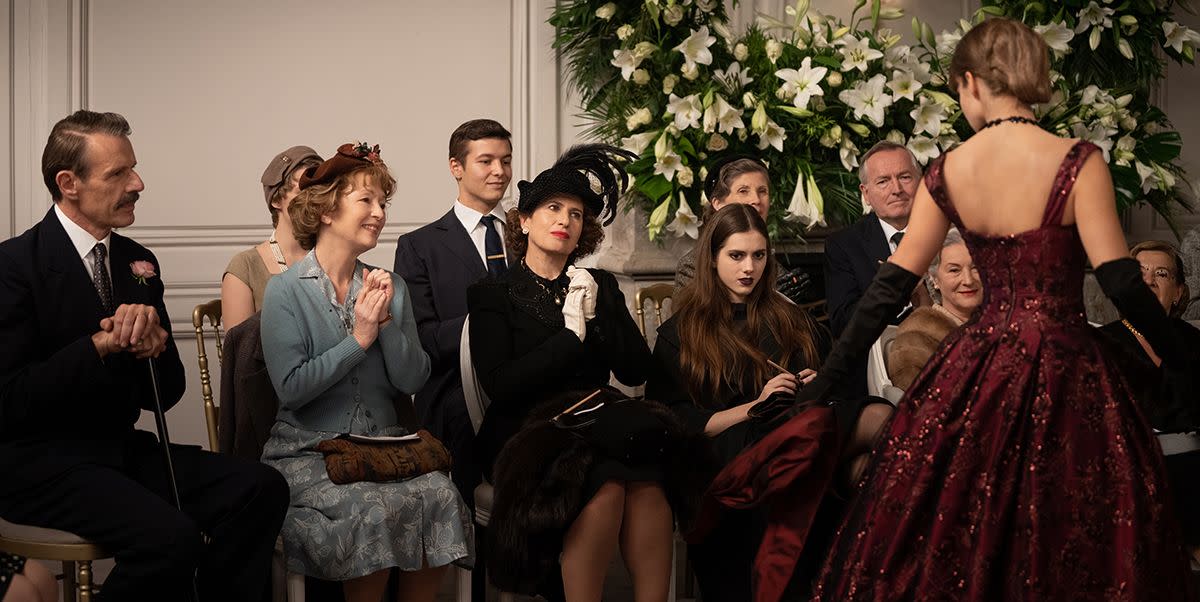Is Mrs. Harris Goes to Paris Based on a True Story?

- Oops!Something went wrong.Please try again later.
- Oops!Something went wrong.Please try again later.
- Oops!Something went wrong.Please try again later.
"Hearst Magazines and Yahoo may earn commission or revenue on some items through the links below."
Mrs. Harris Goes to Paris might be landing in theaters on July 15, but the story behind the film goes back more than 50 years. The plot that plays out on screen began as a novel called Mrs. 'Arris Goes to Paris—the first in a series of books written by Paul Gallico about the housekeeper Ada Harris—but it took more than just time for the narrative to become director Anthony Fabian’s charming movie.
“Why would I want to make a film about a woman who falls in love with a couture dress,” Fabian asks. “The beginning is that since childhood I’ve been a fan of Paul Gallico as a writer, and when I signed with a manager in L.A. he was also the manager of the Gallico estate. One day, he sent me a manuscript of a book of his I hadn’t read, and I was intrigued by it.”
It’s no mystery why he got hooked. The story follows a London housekeeper (Lesley Manville’s Mrs. Harris) who encounters a Christian Dior dress in a client’s home and soon finds herself consumed by the dream of owning one herself. Through a series of convenient miracles, she finds herself in Paris as a client at Dior’s atelier, but things get complicated from there. It’s a film about love, loss, friendship, compassion, and the power of fashion—and features delicious turns from a cast including Isabelle Huppert, Jason Isaacs, Freddie Fox, and Lucas Bravo.
So, did Fabian rely solely on a work of fiction to create his film? You may be surprised.
Any Resemblance…
While Ada Harris is most definitely a fictional character, not everyone in the film follows suit. Christian Dior (played by Phillippe Bertin) was, of course, a real person—and some of the other characters in his orbit are based on real life as well. “[Huppert’s] Madame Colbert is a combination of two of Dior’s muses,” Fabian explains. “There was a woman named Mizza Bricard who was his inspiration, and there was another woman more on the practical side, so she’s a combination of two. Then there was a woman who was the head of atelier, Marguerite Carré, who I turned into a male character because I wanted to have a different energy for the cutter; I imagined a more rigid character. He’s named Mr. Carré, which means ‘square’ in French, but I didn’t even know her name when I named the character.”
After a Fashion
“Everything you see in the film about Dior is inspired by factual reality,” Fabian says. “Even the dresses; all but three of the dresses are exact replicas of Dior designs. Then the three hero dresses are all inspired by Dior dresses but they’re interpretations and not copies.” The production was granted extensive access to Dior archives and historical records, which helped ground the story in reality—and match photos that eagle-eyed fashion fans might already know well. “We were given the architectural plans for the house of Dior, so we were able to create the salon, the staircase, and the dressing rooms in a studio exactly as they were,” Fabian says. “The relationship between those spaces really helped us tell the story. We spent quite a bit of time in those archives to get all of that research right.”
Location, Location, Location
While some key moments in the film were shot in their actual locations, many were filmed on location in Budapest or enhanced with a bit of movie magic. “In Budapest, you can find streets that look very much like Paris; there are some that are absolutely dead ringers.,” Fabian says. “Then the other factor was that we did some studio builds, so you might as well be anywhere. Finally, we did actually shoot some very key exteriors in London and Paris. The Albert Bridge and that beautiful crescent in Belgravia are both the real thing, and so is the pub where they go—the exterior is in London, you can’t find that anywhere else. That also reassures the audience that this is all real.”
Magical Thinking
Of course, a large part of what happens in Mrs. Harris is fictional—but not all of that comes from Gallico’s book. Some was devised by Fabian to help make even the imaginary moments on screen feel more believable. “The key to this story is that it is magic realism, so it has to have an equal dose of magic and reality,” he says. “If you go too far into magic, you won’t believe it; if you go too far into the realism, it wouldn’t have that uplifting fairy tale quality. The choice to have a binmen’s strike [during Mrs. Harris’s time] in Paris seemed like a fun idea with her being a cleaner. That was also party motivated by my desire not to create too much of a chocolate-box world. If this beautiful city is strewn with rubbish, you’re bringing a degree of reality to the fairytale. Getting the balance right was important.”
Likewise, seeing inside the homes of the Dior staff—where they live real lives somewhat less charmed than an existence inside the atelier—helps create a sense of fantasy and reality on screen. “Getting a window into where some of these characters live was very important,” Fabian says. “There are lovely contrasts all the way through the story—between London and Paris but also between the glamour of Dior and the reality of the people who worked there.”
You Might Also Like

